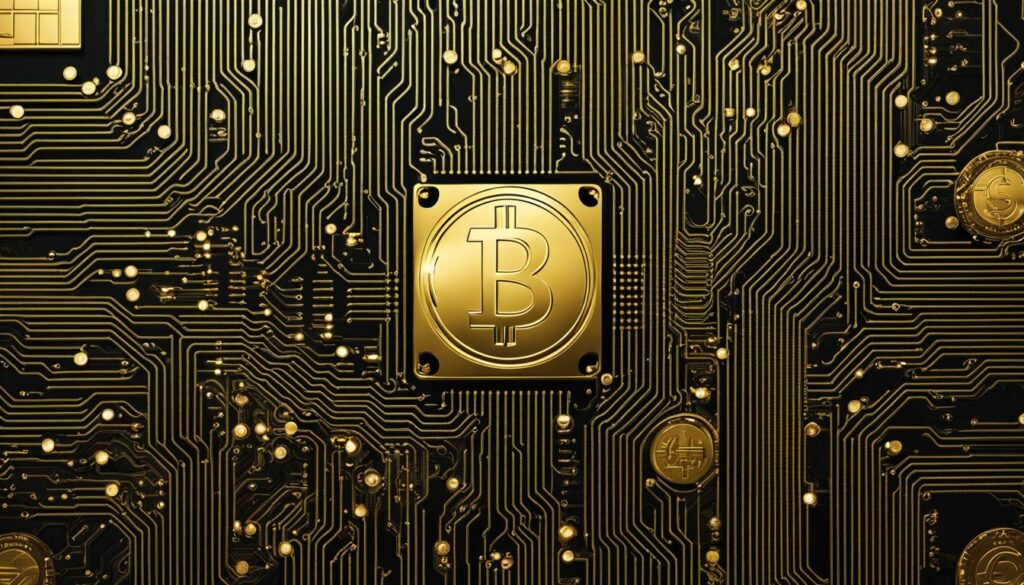Welcome to the world of IT currency, where money is no longer confined to physical form. In today’s digital age, currency in information technology has transformed the way we conduct transactions, revolutionizing the financial landscape. It’s essential for individuals and businesses alike to grasp the concept of IT currency and stay informed about its implications.
So, what exactly is IT currency? It refers to a specialized form of money that exists solely in the online world. Unlike physical currency, IT currency is protected by advanced computer technology, making it fast, secure, and accessible anywhere in the world. Governments, companies, and individuals can create IT currency for various purposes.
Contents
- 1 The Basics of IT Currency
- 2 The Importance of IT Currency
- 3 The Role of IT Currency in Financial Systems
- 4 The Advantages and Challenges of IT Currency
- 5 The Future of IT Currency
- 6 Resources for Learning about IT Currency
- 7 Conclusion
- 8 FAQ
- 8.1 What is IT currency?
- 8.2 What are the types of currency in IT?
- 8.3 What is the importance of IT currency?
- 8.4 What is the role of IT currency in financial systems?
- 8.5 What are the advantages and challenges of IT currency?
- 8.6 What does the future hold for IT currency?
- 8.7 Where can I find resources for learning about IT currency?
- 9 Source Links
Key Takeaways:
- IT currency is a digital form of money that exists only online.
- It is protected by advanced computer technology, ensuring fast and secure transactions.
- Various types of IT currency exist, including cryptocurrencies like Bitcoin and central bank digital currencies.
- IT currency plays a crucial role in enabling online transactions, digital payments, and supporting the growth of e-commerce.
- Understanding IT currency and its challenges is essential for individuals and businesses to succeed in the digital economy.
The Basics of IT Currency
When it comes to digital currency in IT, there is a wide range of options available for online transactions. Digital currencies are a form of electronic money that utilizes special codes and computer techniques, such as cryptography, to ensure security and prevent duplication.
Let’s explore the different types of currency in IT:
Cryptocurrencies
The most well-known type of digital currency is cryptocurrencies. Bitcoin, for example, is a decentralized digital currency that operates on a technology called blockchain. It allows for secure and transparent peer-to-peer transactions without the need for intermediaries like banks.
Central Bank Digital Currencies (CBDCs)
Central bank digital currencies, or CBDCs, are digital representations of a country’s fiat currency. Issued and regulated by central banks, CBDCs offer the advantages of instantaneous transactions and increased financial inclusion.
Tokens
Tokens are digital assets that represent ownership or access to a particular asset or service. These can be created on various blockchain platforms, such as Ethereum, and serve specific purposes within decentralized applications (DApps).
Digital Money or E-Money
Digital money, also known as e-money, is a digital representation of traditional fiat currencies, such as the US dollar or the euro. It can be stored and transferred electronically, making it convenient for online transactions.
Understanding the different types of currency in IT is essential for navigating the digital landscape effectively. Each type has its own characteristics and use cases, catering to diverse needs and preferences.
“Digital currency is at its core a technological innovation, enabling the transformation of traditional financial systems and empowering individuals with more control over their financial transactions.”
As the digital landscape continues to evolve, digital currencies in IT are expected to play an increasingly prominent role in shaping the future of finance.
| Type of IT Currency | Description |
|---|---|
| Cryptocurrencies | Decentralized digital currencies, such as Bitcoin, that operate on blockchain technology and enable peer-to-peer transactions. |
| Central Bank Digital Currencies (CBDCs) | Digital representations of a country’s fiat currency issued and regulated by central banks, offering faster transactions and increased financial inclusion. |
| Tokens | Digital assets created on blockchain platforms, serving specific purposes within decentralized applications (DApps). |
| Digital Money or E-Money | Digital representation of traditional fiat currencies, such as the US dollar or the euro, facilitating convenient online transactions. |
Each type of IT currency has its own set of advantages and use cases, catering to different needs and preferences in the digital world.
The Importance of IT Currency
IT currency plays a crucial role in the technology industry. It facilitates online transactions, enables digital payments, and supports the growth of e-commerce. With the increasing reliance on digital platforms for business operations, IT currency provides a convenient and secure way for organizations to conduct financial transactions.
By embracing IT currency, businesses can stay competitive in the digital age. It offers a more efficient and streamlined method of conducting monetary exchanges, eliminating the need for physical cash or traditional banking systems. This not only saves time but also reduces the costs associated with handling and transporting physical currency.
“IT currency allows businesses to adapt to the rapidly evolving digital landscape, providing a means for them to keep up with the demand for online transactions.”
Furthermore, IT currency ensures the smooth flow of money in the digital ecosystem. It serves as a medium of exchange for digital goods and services, allowing individuals and organizations to participate in the global economy effortlessly. Without IT currency, the growth of e-commerce and online marketplaces would be hindered, limiting the opportunities for businesses to expand their reach and customer base.
The security provided by IT currency is another significant factor. It uses advanced cryptographic techniques to protect transactions, making it difficult for unauthorized parties to access or manipulate the digital assets involved. This level of security gives businesses and customers peace of mind when conducting financial transactions in the digital realm.
In addition to facilitating transactions and enhancing security, IT currency contributes to the overall success of organizations. It provides a transparent and auditable record of financial activities, enabling better financial management and accountability. Moreover, the adoption of IT currency can attract tech-savvy customers and drive innovation within an organization, positioning it as a leader in the digital landscape.
Overall, IT currency plays a vital role in the context of technology. It empowers businesses to navigate the digital landscape, conduct secure transactions, and participate in the global economy. By embracing the potential of IT currency, organizations can unlock new opportunities for growth and success.

The Role of IT Currency in Financial Systems
In the context of information technology, currency plays a crucial role as a medium of exchange in financial systems. It enables individuals and businesses to buy goods and services, transfer funds, and store value. However, the role of currency in IT goes beyond everyday transactions.
Currency in information technology also serves as a foundation for investment and trading. It empowers individuals to speculate on the value of various digital assets, from cryptocurrencies like Bitcoin to tokens and e-money. This opens up new avenues for financial interactions and fosters innovation in the industry.
The Versatility of IT Currency
One of the key advantages of IT currency is its versatility. It provides individuals and businesses with the flexibility to conduct various financial activities in an efficient and seamless manner. Whether it’s making payments, managing investments, or participating in trading platforms, IT currency offers the necessary tools and resources.
“IT currency enables individuals to participate in digital economies, widening access to financial opportunities and promoting economic growth.”
Moreover, IT currency plays a crucial role in shaping financial systems by introducing alternative pathways and disrupting traditional structures. It offers decentralized and transparent solutions that challenge conventional banking models, welcoming new players and introducing diverse financial landscapes.
The Impact on Global Transactions
By embracing IT currency, transactions become faster, more secure, and less dependent on geographical boundaries. The digital nature of IT currency eliminates the need for physical exchange and enables near-instantaneous transfers, even across global distances.
This has significant implications for businesses engaged in international trade. With IT currency, companies can bypass numerous intermediaries and associated fees, reducing costs and improving overall efficiency. These advantages propel businesses towards growth and foster economic collaboration on a global scale.
| Benefits of IT Currency in Financial Systems: | Challenges of IT Currency in Financial Systems: |
|---|---|
|
|
|
|
|
|

Considering these benefits and challenges, it is essential for individuals and organizations to carefully navigate the landscape of IT currency in financial systems. With proper understanding and strategic decision-making, IT currency can be leveraged to foster growth, drive innovation, and navigate the evolving world of digital finance.
The Advantages and Challenges of IT Currency
IT currency, in the context of information technology, presents both advantages and challenges. Understanding these factors is essential for individuals and businesses navigating the digital landscape. Let’s explore the benefits and considerations associated with IT currency.
Advantages of IT Currency
IT currency offers several advantages that contribute to its importance in the digital world:
- Efficiency: IT currency enables faster and smoother transactions compared to traditional payment methods. With just a few clicks, you can transfer funds globally, reducing processing time.
- Reduced costs: By eliminating intermediaries and enabling peer-to-peer transactions, IT currency reduces transaction fees, making it more cost-effective for businesses and individuals.
- Improved financial access: IT currency provides financial services to individuals who may not have access to traditional banking systems. This inclusion empowers underserved populations and fosters financial independence.
- Enhanced security: With advanced cryptography and distributed ledger technology like blockchain, IT currency ensures secure transactions, protecting against fraud and unauthorized access.
- Increased transparency: Due to the public nature of blockchain technology, IT currency transactions are transparent, creating a decentralized and accountable financial ecosystem.

Challenges of IT Currency
While IT currency provides many benefits, it also presents certain challenges that must be addressed:
- Changing regulations: As technology evolves, regulations surrounding IT currency are constantly adapting. The dynamic regulatory environment requires individuals and organizations to stay updated and compliant.
- Price volatility: IT currency values can be highly volatile, leading to potential financial risks. Fluctuating prices may impact investment decisions and require careful market analysis.
- Safety concerns: Cybersecurity threats pose risks in the IT currency space. Users must take precautions to protect their digital wallets and personal information from unauthorized access.
- Scalability issues: As the adoption of IT currency grows, scalability becomes a concern. The technology must be capable of handling increased transaction volumes without compromising speed and efficiency.
- Privacy concerns: The transparency of blockchain technology raises privacy considerations. Balancing transparency and confidentiality is crucial to protect user privacy.
It’s important to consider these challenges and take appropriate measures to mitigate associated risks when engaging with IT currency.
| Advantages of IT Currency | Challenges of IT Currency |
|---|---|
| Efficiency | Changing regulations |
| Reduced costs | Price volatility |
| Improved financial access | Safety concerns |
| Enhanced security | Scalability issues |
| Increased transparency | Privacy concerns |
While IT currency offers numerous advantages, addressing the challenges is crucial to creating a resilient and secure digital financial ecosystem.
The Future of IT Currency
The future of currency in information technology is promising, with increasing adoption and usage. As more individuals become familiar with digital currencies, regulations and rules will likely evolve to create a more stable and secure environment.
Technological advancements, particularly in blockchain technology, will play a crucial role in enhancing the speed and efficiency of IT currency transactions. Blockchain’s decentralized and immutable nature offers unprecedented security and transparency, making it an ideal framework for digital currencies.
Furthermore, IT currency has the potential to promote financial inclusion and reshape the traditional banking system. With the ability to provide secure financial services to individuals without access to traditional banking, IT currency can bridge the gap and empower a broader population.
Integration into Various Aspects of Society
The future holds exciting possibilities for the integration of IT currency into various aspects of society. Here are some potential areas where IT currency can make a significant impact:
- E-commerce: IT currency can streamline online transactions, making online shopping more seamless and secure.
- Remittances: IT currency can revolutionize the remittance industry by offering faster, cheaper, and more accessible cross-border transfers.
- Microtransactions: With the low transaction fees associated with IT currency, microtransactions can become more viable, enabling new business models and supporting content creators.
- Smart Contracts: IT currency can facilitate the execution of smart contracts, automating various processes and reducing the need for intermediaries.
- Supply Chain Management: IT currency can enhance the traceability and transparency of supply chains, ensuring authenticity and reducing fraud.
The Future of IT Currency – Key Takeaways
“The future of IT currency is characterized by increased adoption and usage, as well as the potential for promoting financial inclusion and reshaping the traditional banking system.”
Overall, the future of IT currency is bright, driven by technological advancements and a growing understanding of its potential. As more individuals and businesses embrace digital currencies, the landscape of finance will continue to evolve, opening up new opportunities for innovation and the integration of IT currency into various aspects of society.

| Advantages | Challenges |
|---|---|
| Efficiency | |
| Reduced Costs | Price Volatility |
| Improved Financial Access | Safety Concerns |
| Enhanced Security | Scalability Issues |
| Increased Transparency | Privacy Concerns |
Resources for Learning about IT Currency
Are you eager to deepen your understanding of IT currency and explore the world of digital currency systems? Fortunately, there are numerous resources available to help you expand your knowledge and stay up to date with the latest developments. Whether you’re an individual curious about the intricacies of IT currency or a business looking to leverage its potential, these resources can provide valuable insights and educational materials.
1. Websites
uscurrency.gov is a comprehensive website that offers information on various aspects of IT currency. It provides detailed explanations of the security features found in U.S. currency and offers educational materials that delve into the history and significance of physical and digital currencies. This resource can be an excellent starting point for gaining a solid foundation in the world of IT currency.
2. Online Courses
If you prefer a structured learning experience, online courses dedicated to IT currency are a great option. Platforms like Coursera, Udemy, and LinkedIn Learning offer a wide range of courses taught by industry experts. These courses cover topics such as blockchain technology, cryptocurrencies, digital payments, and the future of finance. Completing an online course can equip you with the knowledge and skills necessary to navigate the ever-changing landscape of digital currency systems.
3. Forums and Communities
Engaging with online forums and communities can provide valuable insights and foster discussions with like-minded individuals interested in IT currency. Platforms like Reddit, BitcoinTalk, and Stack Exchange have dedicated sections where you can ask questions, share knowledge, and learn from experienced users. These communities are an excellent resource for staying updated on the latest trends, discussing emerging technologies, and receiving practical advice.
4. Books and Publications
For an in-depth exploration of IT currency, books offer comprehensive and analytical perspectives. Well-regarded titles such as “Mastering Bitcoin” by Andreas M. Antonopoulos and “The Age of Cryptocurrency” by Paul Vigna and Michael J. Casey provide valuable insights into the history, technology, and future implications of IT currency. Additionally, industry publications like CoinDesk and CoinTelegraph offer up-to-date news, analysis, and opinion pieces on the world of digital currencies.
Remember, staying informed and continually learning about IT currency is vital to navigate the evolving landscape of digital transactions successfully. By leveraging the resources mentioned above, you can enhance your understanding of IT currency and confidently navigate the world of digital currency systems.
| Resource | Description |
|---|---|
| uscurrency.gov | A comprehensive website offering information on the security features of U.S. currency and educational materials. |
| Online Courses | Platforms like Coursera, Udemy, and LinkedIn Learning provide a wide range of courses on IT currency and related topics. |
| Forums and Communities | Engage with forums and communities such as Reddit, BitcoinTalk, and Stack Exchange to discuss IT currency with other enthusiasts and experts. |
| Books and Publications | Explore in-depth books like “Mastering Bitcoin” and industry publications like CoinDesk and CoinTelegraph for comprehensive insights into IT currency. |
Conclusion
In today’s digital age, currency in the context of IT plays a vital role in enabling fast and secure online transactions. It has revolutionized the way businesses operate and has the potential to transform financial systems globally. By understanding the basics of IT currency, recognizing its importance, and acknowledging the challenges it presents, individuals and organizations can position themselves for success in the ever-changing technological landscape.
IT currency offers numerous advantages, including efficient and cost-effective transactions, improved financial access, enhanced security, and increased transparency. It empowers businesses to streamline their operations and expand their reach in the digital economy. However, it is important to remain informed about the developments in IT currency, such as changing regulations and emerging technologies, to navigate the landscape effectively.
By leveraging the advantages of IT currency and staying informed about its advancements, businesses can stay competitive and adapt to the evolving digital ecosystem. Embracing IT currency paves the way for new opportunities, innovation, and the potential for financial inclusion. As technology continues to progress, IT currency will further shape and redefine the financial industry, making it essential for all stakeholders to stay updated and explore its immense potential.
FAQ
What is IT currency?
IT currency refers to a specialized form of money that exists solely in the online world. It is different from physical currency and is protected by advanced computer technology.
What are the types of currency in IT?
There are various types of IT currency, including cryptocurrencies like Bitcoin, central bank digital currencies (CBDCs), tokens, and digital money or e-money.
What is the importance of IT currency?
IT currency plays a crucial role in the technology industry by facilitating online transactions, enabling digital payments, and supporting the growth of e-commerce.
What is the role of IT currency in financial systems?
IT currency serves as a medium of exchange in financial systems, allowing individuals and businesses to buy goods and services, transfer funds, and store value. It also plays a role in investment and trading.
What are the advantages and challenges of IT currency?
IT currency offers benefits such as efficiency, reduced costs, improved financial access, enhanced security, and increased transparency. However, it also presents challenges such as changing regulations, volatility, safety concerns, scalability issues, and privacy concerns.
What does the future hold for IT currency?
The future of IT currency is characterized by increased adoption and usage. Technological advancements, improved blockchain technology, and potential financial inclusion are expected to shape its future.
Where can I find resources for learning about IT currency?
Websites like uscurrency.gov and online courses, forums, and books dedicated to IT currency provide information and educational materials for individuals and businesses to learn more.




